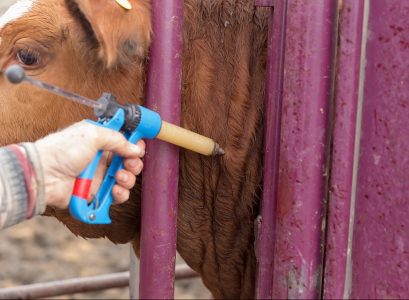



Vaccination Of The Beef Herd: Tips to Remember
Vaccines stimulate the immune system of the animal to produce antibodies. Antibodies (or immunoglobulins) are proteins created by cells in the blood or in various lymphoid tissues that can be found in the intestine or upper respiratory tract.
These specific proteins help to destroy various infectious organisms that can cause disease. Cattle also produce antibodies when they are naturally exposed to infectious organisms.
Vaccines are certainly a primary component of our modern herd health programs, but it is important to remember that they rarely provide absolute protection and other management components such as biosecurity, nutrition and environmental management also play important roles in protecting the herd from infectious diseases.
When cattle are exposed to infectious pathogens, the immune system is stimulated to respond to these infections. It takes time for this complex machinery to respond to a pathogen when it is initially exposed to the antigen (either through vaccination or natural infection).
As a result, antibodies aren’t created in time to prevent disease from occurring on initial exposure. However, the immune system is able to “learn” and develop a specific response to a pathogen (a disease-causing agent) such as a particular bacteria or virus or parasite. This is important because when an animal is exposed to the disease for a second time, the immune system has memory cells that are programmed to respond to antigens they have previously encountered.
Vaccines can be divided into two main categories, modified live vaccines and killed vaccines. A modified live vaccine contains living bacterial or viral organisms. The infectious organism has been “modified” by growing the virus in abnormal host cells or by growing a bacteria on an abnormal media. As they replicate this cycle over and over, the virus or bacteria begins to lose some of the factors that may cause disease and the newly modified living bacteria or virus can now stimulate immunity without causing disease.
Killed vaccines usually involve isolating a field strain of a bacteria or a virus from an outbreak of disease, growing the pathogen, then killing it through chemical or physical means (e.g. adding a chemical such as formalin or by using ultraviolet light). This killed organism can then be injected without causing disease, but the various proteins on the bacteria or virus that cause an immune response are still present.
Some Important Points to Remember When Using Vaccines:
- Read the label! The dose, withdrawal times, expiration date, timing, route of administration and safety information are all there.
- Don’t combine vaccines! Mixing various vaccines together in one syringe can inactivate both vaccines. Multiple vaccinations should be spaced apart in separate locations. Follow the label directions.
- Mix enough vaccine for only one hour or less. Keep the vaccine away from extreme heat or cold.
- Get the air out of your automatic syringe. Trapped air can dramatically affect the amount of vaccine you are actually administering.
- Keep your equipment clean. Use hot water only for cleaning automatic syringes. Disinfectants can leave a residue that destroys modified live vaccines.
- Use an appropriate sized needle for the job. For cattle usually a 16-gauge needle that is ½” – ¾” long for subcutaneous injections and 1” – 1 ½” long for intramuscular injections.
- Change needles frequently (at least every 10-25 animals) and give all intramuscular injections in the neck area. Don’t contaminate your vaccine bottle by utilizing a used dirty needle when you load your syringe. Only sterile needles should be used in the vaccine bottle.
- Keep detailed records. Keep track of what vaccines you use including serial and lot numbers.


